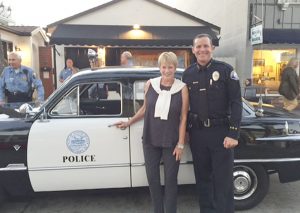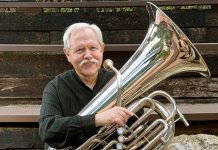
Balboa Island’s Historical Society celebrated the island’s 10-carat Diamond Anniversary by honoring the Newport Beach Police Department last Friday evening at the society’s museum on Marine Avenue.
For nearly two hours, three retired Newport officers figuratively captured the nearly 100 attendees with memories of how law enforcement was when they started their careers. Audience laughter ricocheted around the tightly packed forecourt as the three shared their memories.
Newly selected Police Chief Jon Lewis, who started his career as a Newport police cadet at age 18 when he was a freshman at California State University, Long Beach, spent the final 15 minutes explaining the qualities required for today’s crop of cops, as well as the operational procedures insisted upon in today’s law enforcement environment.
It could best be described as the difference between an old, iron-sighted six-shooter and a laser-aimed, polycarbonate semi-automatic pistol. Clearly, however, despite operational differences, policemen of yesterday served with the same intensity and purpose as those patrolling our streets and investigating crimes today.
Retired Officer Stan Bressler, Sgt. Mike McDonough and Chief Neil Purcell (who ended his career as head of Laguna Beach PD), all grew up in Newport, and served on the department as soon as they turned 21. They learned from their predecessors that when on patrol, they were their own management – a necessity, because radio communications then were less dependable than a homing pigeon, and often there were only two on patrol for the entire city on any given shift.
Newport Beach remained a quiet beach community in winter, but changes were coming. The kids in the 1950s and 60s would sit on the curb when you asked them to. In the 70s, the kids would ask you “Why?” Chief Purcell recounted.
Until there was more civic accountability, knuckles and nightsticks were part of every officer’s weekend conversation. After all, there often were only two cops on duty at one time. Sometimes, even Marines on liberty would come to the aid of a cop in a tussle.
Sgt. McDonough recounted the time that he had to arrest a troublesome Marine, who was a hand-to-hand combat specialist. That fight lasted more than 10 minutes. The radio wouldn’t reach Dispatch, which was only 30 yards away. Finally, a citizen called on a traditional phone.
“Police poured out of the station like Keystone cops, and finally subdued the Marine,” McDonough said.
Newport has always had its favorite drunks. There was one cirrhotic legend named Corning, “the training drunk” for the department. Whenever the station needed painting, the duty cops would arrest Corning. The local judge would determine how many days it would take to paint the jail, then sentence Corning for the required time.
Their “biggest” drunk bust involved a seven-foot-tall, 300-pound man whose wrists were as thick as thighs. When five cops finally subdued him, they couldn’t put on the cuffs. Physically drained from the wrestling match, the giant quit abruptly, agreeing to be placed in the squad car sans cuffs.
Then there were the encounters with famed drug proponent Dr. Timothy Leary and his “high” family. Purcell, then in Laguna, arrested Leary shortly after the LSD proponent had returned from self-exile in Europe, two years after he had escaped from prison.
Those stories could have gone on for as long as their careers, but Chief Lewis wanted to let the audience know about modern policing, underscoring that the public expects today’s cop to be all things: brave, fit, experts in mental health and law, be good decision makers – all while performing under stress.
“We are under scrutiny, and we’re held accountable,” Lewis said.
But the Department doesn’t act by itself, it operates in tandem with other city departments, from public works to library, and in cooperation with the community at large, he explained. “Real community policing.”
Although policing has changed from the patrol days of Bressler, McDonough and Purcell, “Today we’re considered a world class police department. But know that we all stand on the shoulders of these giants,” Chief Lewis concluded, gesturing toward the three men who were smiling in remembrance.




